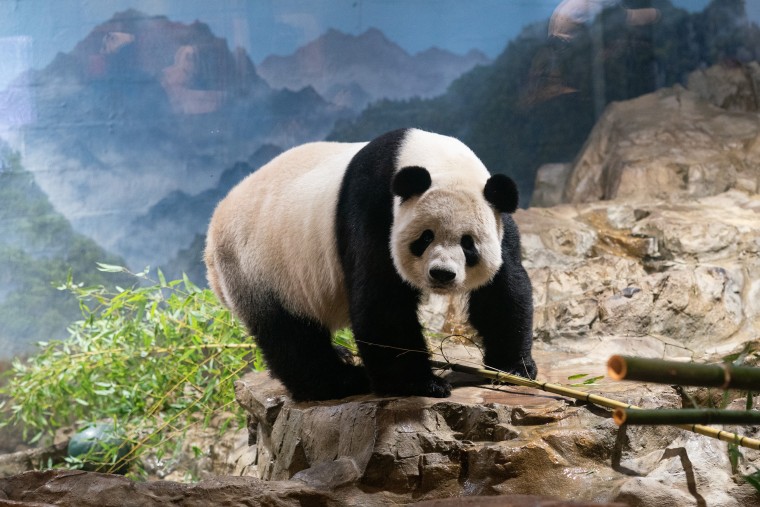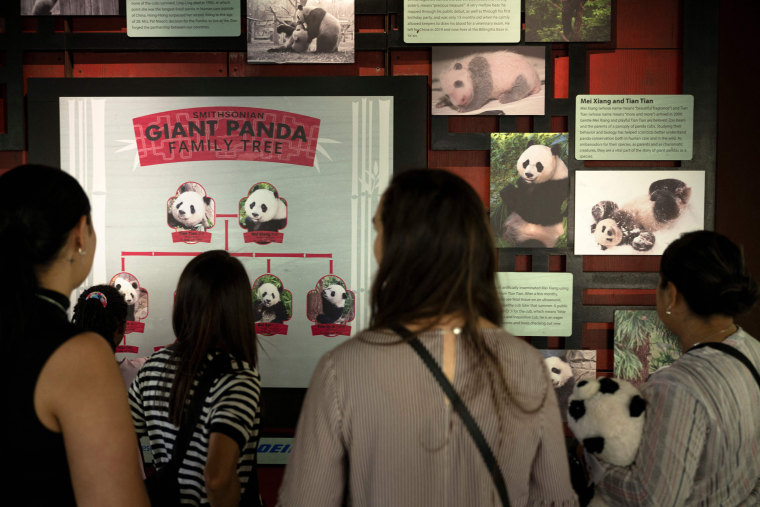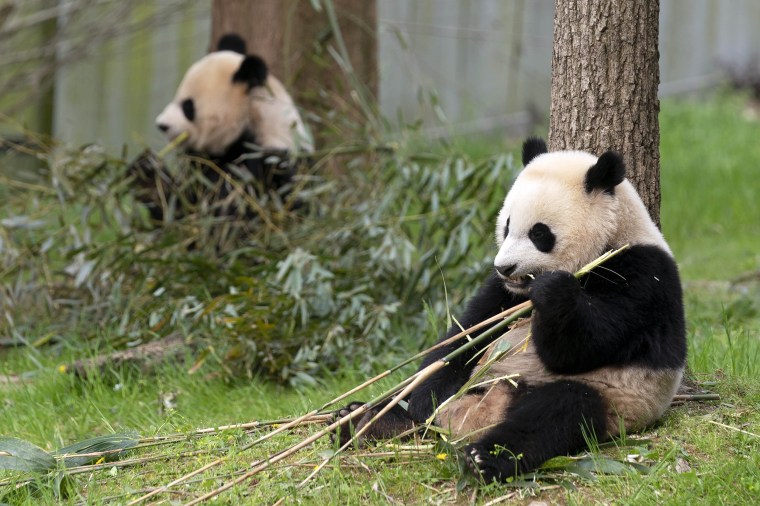HONG KONG — Some of the last giant pandas in the United States are heading back to China.
The National Zoo announced last month that its three pandas — Mei Xiang, Tian Tian and their 3-year-old male cub, Xiao Qi Ji — will return to China by Nov. 15, earlier than expected.
Panda fans have been flocking to say goodbye to the black-and-white bears, who have long been one of the zoo’s main attractions.
“It’s probably going to be a long time, possibly one of the last times I see a panda in captivity,” Ryan Nickol, who has traveled from Pennsylvania to see the pandas multiple times in recent weeks, told NBC News. “So it’s pretty frustrating and also a little sad.”
Their departure leaves Zoo Atlanta as the only one in the U.S. with a giant panda program. But the loan agreement for the zoo’s four pandas expires next year, raising the prospect that there could be no pandas in the U.S. for the first time since 1972.
The U.S. is not the only country facing the loss of the beloved bears, which China has long gifted to other countries in what is dubbed “panda diplomacy.” The only pair of pandas in Britain is set to return to China from the Edinburgh Zoo by the end of the year, while Australia and China are negotiating the extension of a loan agreement for two pandas at the Adelaide Zoo that expires next year.
Depending on what happens, all three countries could be panda-less by 2024.
The panda exodus comes as the U.S. and its allies are at odds with China over a number of issues including trade, technology, the status of Taiwan and China’s stance on wars in the Middle East and Ukraine. Both the U.S. and China have expressed interest in improving ties, and President Joe Biden and Chinese President Xi Jinping are expected to meet in San Francisco this month, their first interaction in a year.
Animal keepers and curators at the National Zoo have been preparing the pandas for their 20-hour journey by crate-training them.
“The pandas absolutely love their crates,” said animal keeper Mariel Lally, who is traveling with them on a chartered FedEx flight. “Some pandas, like Mei Xiang, actually don’t want to leave their crate.”
“We have to bribe them with food to get them out of it,” she added.
The pandas are expected to spend much of the flight sleeping and eating. The zoo plans to bring about 200 pounds of bamboo for the flight, in addition to other food like apples, carrots and sweet potatoes.
Mei Xiang and Tian Tian arrived at the National Zoo in 2000 under a 10-year agreement that has been renewed three times since 2010. Xiao Qi Ji, whose name means “little miracle,” was born in 2020 as a result of artificial insemination.
Efforts to renew the zoo’s current panda agreement, which ends Dec. 7, have been unsuccessful.
Laurie Thompson, the zoo’s assistant curator of giant pandas, said the trio’s return to China would be difficult for the keepers who see them, as she says, “almost more than I see my family.”
“It’s a little bit heartbreaking to not have them here,” she said.
The first giant pandas came to the U.S. in 1972 under President Richard Nixon, after he made a historic visit to China that paved the way for the establishment of diplomatic relations in 1979.

“It’s basically a symbol of friendship between China and the rest of the world,” said Chee Meng Tan, an assistant professor at Nottingham University Business School’s Malaysia campus who has studied panda diplomacy.
The giant panda, which is endemic to China, is no longer endangered but still considered at risk. There are an estimated 1,800 in the wild and an additional 600 living in captivity around the world, with foreign zoos paying China rent on the bears that goes toward conservation efforts.
The lapsing of the panda agreements is an indicator of the “generally worsening” U.S.-China relationship, as each country takes actions that hurt the other but are ultimately counterproductive, said Graham Allison, a professor of government at Harvard and former Defense Department official.
“This is a good example because this is not going to make the folks that came to see the panda happier,” he said. “It will make them sadder, and they’re more likely to blame China than they are the U.S.”
Pandas have already been a point of contention amid U.S.-China tensions. Ya Ya, a panda with a chronic skin condition that returned to China from the Memphis Zoo this spring, became the subject of online nationalistic fervor after animal welfare activists accused the zoo of mistreating her and Le Le, a 25-year-old panda that died in February. Both the zoo and Chinese officials said the pandas received excellent care.
In the U.S., Rep. Nancy Mace, R-S.C., introduced a bill last year that would “give freedom to the pandas and allow pandas born in the United States to stay in the United States.”
The U.S. and China should continue the exchange of pandas no matter how bad their relationship is, said Victor Gao, vice president of the Center for China and Globalization in Beijing and chair professor at Soochow University.

“Although we have a quite intense relationship, pandas could contribute a lot to alleviating it,” he said.
One country that received two new pandas in 2019 is Russia, which has grown closer to China, especially since President Vladimir Putin’s 2022 invasion of Ukraine. Putin and Xi both attended the opening ceremony for the Panda Pavilion at the Moscow Zoo, which Xi said would “become another good story of friendship between the Chinese and Russian people.”
Although the National Zoo pandas are leaving sooner than expected, their departure has been long anticipated.
“When we entered into this relationship 23 years ago, we knew this was the eventuality,” said Bryan Amaral, the zoo’s senior curator of pandas. “So we’re happy at the same time that we’ve been able to sort of cross the finish line with three healthy, well-adjusted pandas going back to China.”
Larissa Gao reported from Hong Kong and Megan Lebowitz from Washington.

